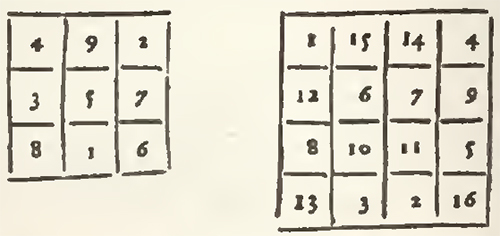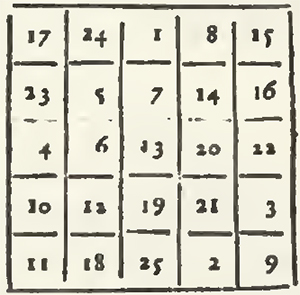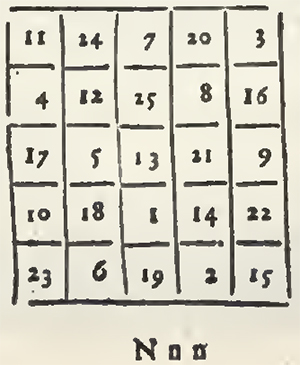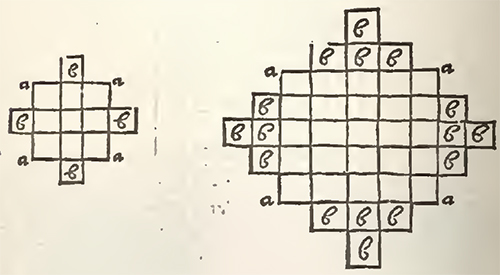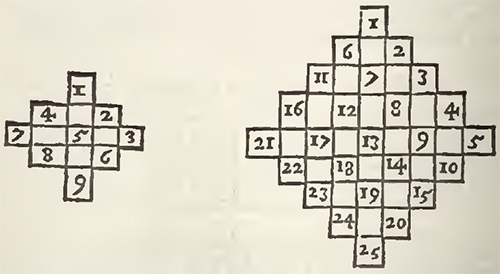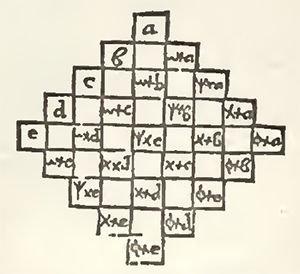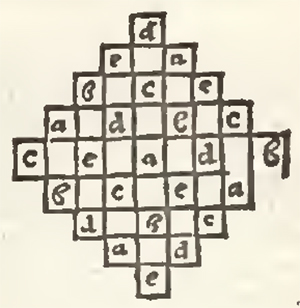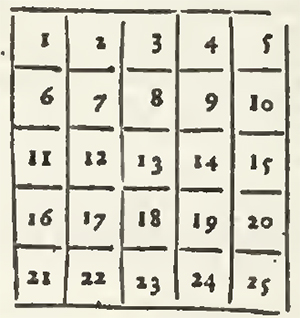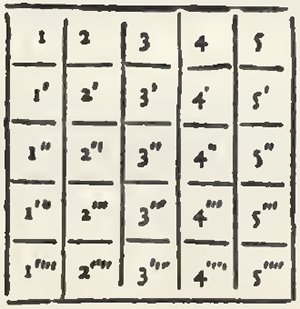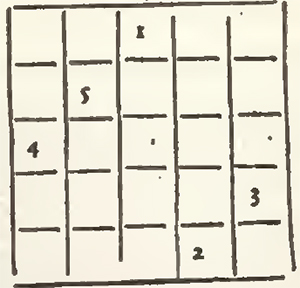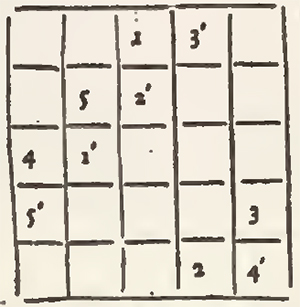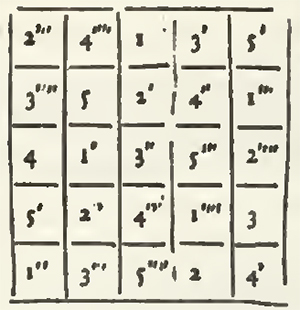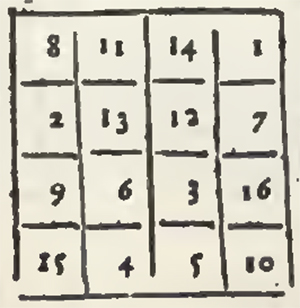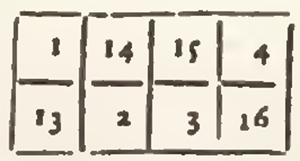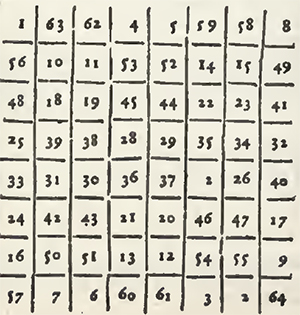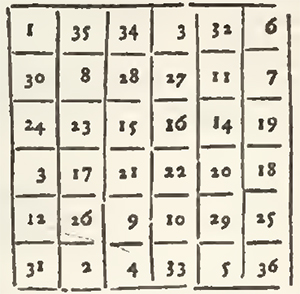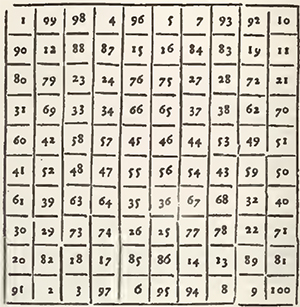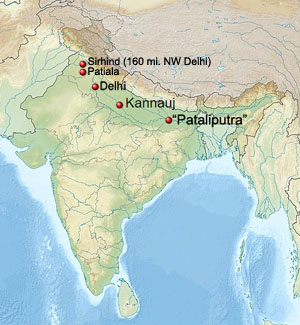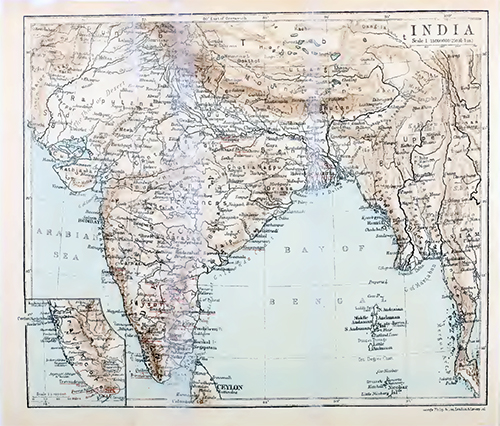Tome II
by Monsieur De La Loubere
Envoy Extraordinary from the French King, to the King of Siam, in the years 1687 and 1688. Wherein a full and curious Account is given of the Chinese Way of Arithmetick, and Mathematick Learning. In Two Tomes, Illustrated with Sculptures. Done out of French, by A.P. Gen. R.S.S.
1693
Cassini is also credited with introducing Indian Astronomy to Europe. In 1688, the French envoy to Siam (Thailand), Simon de la Loubère, returned to Paris with an obscure manuscript relating to the astronomical traditions of that country, along with a French translation. The Siamese Manuscript, as it is now called, somehow fell into Cassini's hands. He was intrigued enough by it to spend considerable time and effort deciphering its cryptic contents, also determining on the way that the document originated in India. His explication of the manuscript appeared in La Loubère's book on the Kingdom of Siam in 1691.
-- Giovanni Domenico Cassini, by Wikipedia
Tome II, Pg. 64-67
CHAP. XI. What the Siameses do know of the Mathematics.
The great Heat of Siam, repugnant to all application of Mind.
The quick and clear Imagination of the Siamese should seem more proper for the Mathematics, than the other Studies, if it did not soon weary them; but they cannot follow a long thread of Ratiocinations, of which they do foresee neither the end nor the profit. And it must be confessed for their Excuse, that all application of Mind is so laborious in a Climate so hot as theirs, that the very Europeans could hardly study there, what desire soever they might have thereunto.
The Ignorance of the Siameses touching the principal parts of Mathematics.
The Siameses do therefore know nothing in Geometry or Mechanics, because they can be absolutely without them: And Astronomy concerns them only as far as they conceive it may be assistant to Divination. They know only some Practical part thereof, the Reasons of which they disdain to penetrate; but of which they make use in the Horoscopes of particular Persons, and in the Composition of their almanac, which, as it were, is a general Horoscope.
Of the Siamese Calendar, and why they have two Epocha's.
It appears that they have twice caused their Calendar to be reformed by able Astronomers, who, to supply the Astronomical Tables, have taken two arbitrary Epocha's, but yet remarkable for some rare Conjunction of the Planets. Having once established certain Numbers upon these Observations, they by the means of several Additions, Subtractions, Multiplications and Divisions, have given for the following Years the secret of finding the place of the Planets, almost as we find the Epact of every Year, by adding eleven to the Epact of the Year foregoing.
The most Modern is evidently Arbitrary.
The most Modern of the two Siamese Epocha's, is referred to the Year of Grace 638. I gave to Mr. Cassini, Director of the Observatory at Paris, the Siamese Method of finding the place of the Sun and Moon by a Calculation, the ground of which is taken from this Epocha. And the singular Merit which Mr. Cassini has had of unfolding a thing so difficult, and penetrating the Reasons thereof, will doubtless be admired by all the Learned. Now as this Epocha is visibly the ground only of an Astronomical Calculation, and has been chosen rather than another, only because it appear'd more commodious to Calculation than another, it is evident that we must thence conclude nothing which respects the Siamese History; nor imagine that the Year 638, has been more Famous amongst them than another for any Event, from which they have thought fit to begin to compute their Years, as we compute ours, from the Birth of the Saviour of the World.
The most Ancient also appears Arbitrary.
By the same Reason I am persuaded, that their most Ancient Epocha, from which in this Year 1689, they compute 2233 Years, has not been remarkable at Siam for any thing worthy of Memory, and that it proves not that the Kingdom of Siam is of that Antiquity. It is purely Astronomical, and serves as a Foundation to another way of calculating the places of the Planets, which they have relinquished for that new Method which I have given to Mr. Cassini. Some person may discover to them the Mistakes, where in process of time this ancient Method must fall; as in time we have found out the Errors of the Reformation of the Calendar made by the Order of Julius Cesar.
And is not taken from the death of Sommona Codom [Buddha]
The Historical Memoirs of the Siameses reascending, as I have remark'd in the beginning, to 900 Years, or thereabouts, it is not necessary to seek the Foundation of their Kingdom in the 545th Year before the birth of Jesus Christ; nor to suppose that from this time they have enjoyed a Succession of Kings, which they themselves are absolutely ignorant of. And tho' the Siameses do vulgarly report, that this first Epocha, from which they compute, as I have said, 2233 Years is that of the death of their Sommona-Codom [Buddha]; and altho' it refers almost to the time in which Pythagoras liv'd, who has sowed in the West the Doctrine of the Metempsychosis, which he had learnt from the Egyptians, yet it is certain that the Siameses have not any Memoirs of the time in which their Sommona Codom [Buddha] might have lived: And I cannot persuade my self that their Sommona-Codom [Buddha] could be Pythagoras, who was not in the East, not that their ancient Epocha is other than Astronomical and Arbitrary, no more than their Modern Epocha.
Man, -- ennemi de Sommona-Codom. Les Siamois le representent comme une espece de monstre, avec une tete herissee de serpents, un visage fort large et des dents horriblement grandes.
Google translate: Man, -- enemy of Sommona-Codom. The Siamese represent him as a species of monster, with a head bristling with snakes, a very large face and horribly large teeth.
-- Dictionnaire Infernal, by Jacques Collin de Plancy, 1818
Butta, place par les Indiens au rang des Dieux. -- Ne d'une vierge par le cote. Memoires, Vol. XXVI, 771. Appele aussi Puti. -- Sommona-condom chez les Siamois, que M. De Guignes interprete le Semaneen-condom. Ibid. 774. Les Arabes l'appellent Boudasp ou Boudass. -- Les Persans, Schekmouniberkari. -- Les Chinois, Tche-kia ou Chekiameouni, Foteou ou Foto; mais son nom le mieux connu est Fo ou Foto. -- Les Siamois le nomment Prah-poadi-tchaou, Sammana-khutama & Phutta. -- Hyde le derive du persan Butt. -- Leibnitz veut que ce foit le Wodin du nord. -- Chez les Indiens Butta signifie Mercure, 776. Les fables des Indiens, & le peu de detail des historiens, empechent de fixer le temps de sa naissance. -- Masoudi le place fous des regnes inconnus. -- Les Arabes le font naitre dans le Kaschmir, d'ou il passe dans les Indes & fonde le Sabeisme. -- Les Chinois font naitre Fo aussi dans le Kaschmir. Mem. Volume XXVI, 777 & 778. L'accord des Chinois & des Arabes semble exclure le sentiment de ceux qui le font naitre a Siam ou a Ceilan. -- Deux epoques de sa naissance chez les Chinois, dont la difference est de trois cents quarante-quatre ans. Ibidiem, 778 & 779. M. De Guignes, pour les accorder, etablit que le system de cette religion etant fonde sur la metempsycose, ils auront adopte les fondateurs des autres religions, comme de nouvelles apparitions de leur Dieu. -- Les Bonzes trouvent, en consequence, sept Fo, 779. Soutiennent que Vischnou a reparu fous le nom de Krischtenou, & y joignent toutes les circonstances qui indigent J.C. 780. M. De Guignes pense qu'ils ont adopte de meme Zoroastre, & fait voir que l'epoque de Fo, la moins ancienne, quadre avec le temps ou a paru Zoroastre, 780, 781 & 785. Que les Indiens ont connu Zoroastre, 783. Que Darius, roi de Perse, transporte un pyree dans le Kaschmir, & oblige les Rois qui lui etoient foumis a y veniradorer un cypres, 784. D'ou ceux qui venoient au pyree auront pu croire que Zoroastre etoit une nouvelle apparition de Butta. -- Ils conservent des traces du manisine, dans le respect qu'ils portent au feu & a l'arbre casta. -- M. De Guignes conclut que la vraie epoque de Fo fera la plus ancienne des deux, & soutient que ce qu'on troube de Christianisme dans la religion des Indes, provient du commerce des Occidentaux; car on y troube des mots Romains consacres a la religion. -- Naissance de Fo. -- Conformite de ce qu'en disent les historiens Chinois & S. Jerome, 785. Fables que debitent les Chinois a ce sujet. -- Ses differentes renaissances. -- Est le meme que Vischnou, dont la dixieme apparition est sous la figure de Boudha. -- Son mariage. -- A un fils. -- Se retire dans les deserts avec cinque Philosophes. -- Sa mort. -- Devient Dieu, 786. Enseigne a sa mort que tout ce qu'il avoit dit etoit figure. -- Que son veritable sentiment etoit que tout fortoit du neant & y retournoit. -- Son principe favori, suivant les Missionaires, est l'atheisme. -- Ses dernieres paroles produisent deux sectes, l'une suit la doctrine exterieure, l'autre la doctrine interieure. -- Les sectateurs de la doctrine exterieure connus sous les noms de Brahmes, Bonzes, Lamas, Talapoins. -- Leurs principes. -- Nombre de leurs divinites. -- Leur veneration pour l'eau du Gange. -- Leur ame se perfectionne a force de transmigrations, jusqu'a ce qu'elle occupe le corps d'un Samaneen. Memoires, Vol. XXVI, 787 & 788.
Google translate: Butta, placed by the Indians in the rank of the Gods. -- Not of a virgin by the side. Memoirs, Vol. XXVI, 771. Also called Puti. -- Sommona-condom among the Siamese, which M. De Guignes interprets as Semaneen-condom. Ibid. 774. The Arabs call it Boudasp or Boudass. -- The Persians, Schekmuniberkari. -- The Chinese, Tche-kia or Chekiameouni, Foteou or Foto; but its better known name is Fo or Foto. -- The Siamese call it Prah-poadi-tchaou, Sammana-khutama & Phutta. -- Hyde the derivative of the Persian Butt. -- Leibnitz wants it to be the Wodin of the north. -- Among the Indians Butta means Mercury, 776. The fables of the Indians, and the lack of detail of historians, prevent us from fixing the time of his birth. -- Masoudi places him in the realms of the unknown. -- The Arabs give birth to him in Kaschmir, from where he goes to India & founds Sabeism. -- The Chinese are also having Fo born in Kaschmir. Same. Volume XXVI, 777 & 778. The agreement of the Chinese and the Arabs seems to exclude the feeling of those who cause it to be born in Siam or Ceilan. -- Two epochs of his birth among the Chinese, the difference between which is three hundred and forty-four years. Ibidiem, 778 & 779. M. De Guignes, to agree with them, establishes that the system of this religion being founded on metempsychosis, they will have adopted the founders of other religions, as new apparitions of their God. -- The Bonzes find, consequently, seven Fo, 779. Maintain that Vischnou has reappeared in the name of Krischtenou, & add to it all the circumstances which indigate J.C. 780. M. De Guignes thinks that they adopted Zoroaster in the same way, & shows that the time of Fo, the least ancient, squares with time where Zoroaster appeared, 780, 781 & 785. That the Indians knew Zoroaster, 783. That Darius, king of Persia, transports a pyreus in the Kaschmir, and obliges the Kings who were furnished to him to come there to adore a cypress, 784. From where those who came to the pyres could have believed that Zoroaster was a new appearance of Butta. -- They retain traces of the manisine, in the respect they have for fire & the casta tree. -- M. De Guignes concludes that the true period of Fo will be the oldest of the two, & maintains that what is disturbed by Christianity in the religion of the Indies, comes from the trade of Westerners; for there are found Roman words devoted to religion. -- Birth of Fo. -- Conformity with what Chinese historians say & S. Jerome, 785. Fables the Chinese utter on this subject. -- Its different revivals. -- Is the same as Vishnu, whose tenth appearance is under the figure of Buddha. -- His wedding. -- Has a son. -- Withdrew into the deserts with five Philosophers. -- His death. -- Becomes God, 786. Teach at his death that all he had said was a figure. -- That his real feeling was that everything was coming out of nothingness and returning to it. -- His favorite principle, according to the Missionaries, is atheism. -- His last words produce two sects, one following the outer doctrine, the other the inner doctrine. -- The followers of the exterior doctrine known under the names of Brahmes, Bonzes, Lamas, Talapoins. -- Their principles. -- Number of their divinities. -- Their reverence for the water of the Ganges. -- Their soul is perfected by dint of transmigrations, until it occupies the body of a Samaneen. Memoirs, Vol. XXVI, 787 & 788.
-- Table Des Matieres: Contenues dans l'Histoire & dans les Memoires de l'Academie Royale Des Inscriptions Et Belles-Lettres, depuis le Volume XXIII, jusques & compris le Volume XXXII. Tome Trente-troisieme. A Paris, De L'Imprimerie Royale. LM. DCCLXX. [Google translate: Table Of Contents: Contained in the History & in the Memoirs of the Royal Academy of Inscriptions and Belles-Lettres, from Volume XXIII, up to & including Volume XXXII. Volume Thirty-Third. In Paris, From the Royal Printing. LM. 1770.]
The Variety of Style in their Dates.
But if the Siameses do still make use thereof in their Dates, after having relinquish'd it in their Astronomical Calculations, it is because that in things of Style they do not easily alter the Usages unto which they are accustomed; and yet they cease not to date sometimes with respect to that modern Epocha which they have taken, as I have said, from the Year of our Lord 638. But their first Month is always the Moon of November or December, in which they depart not from the ancient Style, even then when they date the Year according to their new Style; tho' the first Month of the Year, according to this new Style, be the fifth or sixth of the old Style.
What the Siameses do think of the System of the Worlds
This, in few words, is the whole Skill of the Siameses in Astronomy. Moreover, they understand nothing of the true System of the World, because they know nothing by Reason. They believe therefore, like all the East, that the Eclipses are caused by some Dragon, which devours the Sun and Moon (perhaps by reason of the Astronomer's metaphorical way of speaking, that the Eclipses are made in the Head and Tail of the Dragon:) And they make a great noise, with Fire-shovels and Kettles, to scare and drive away this pernicious Animal, and to deliver those beauteous Planets. They believe the Earth Four-square, and of vast Extent, on which the Arch of Heaven rests at its extremities, as if it was one of our Glass-Bells with which we cover some of our Plants in our Gardens. They assert, that the Earth is divided into four habitable parts of the World, so separated one from the other by Seas, that they are, as it were, four different Worlds. In the middle of these four Worlds, they suppose an exceeding high Pyramidal Mountain with four equal sides, called, Aon pra Sommene (Caon signifies, a Mountain, and to Mount:) and from the Surface of the Earth, or the Sea, to the top of this Mountain, which, as they say, touches the Stars, they compute 85,000 lods, and every lod contains about 8,000 Fathoms. They reckon as many lods from the Surface of the Sea to the Foundations of the Mountain; and they likewise reckon 84,000 lods extent of Sea from each of the four sides of this Mountain to every of the four Worlds which I have mentioned. Now our World, which they call Tchiampion, lies, as they report, to the South of this Mountain, and the Sun, Moon and Stars do incessantly turn round it; and it is that, which according to them, makes the Day and Night. At the top of this Mountain is a Heaven, which they call Intratiracha, which is surmounted by the Heaven of Angels. This Sample, which is all I know thereof, will suffice to demonstrate their Gtossness; and if it does not exactly accord to what others have writ before me concerning this matter, we must not more admire the variety of the Siamese Opinions in a thing they understand not, than the contrariety of our Systems in Astronomy, which we pretend to understand.
The Indians are Superstitious proportionably to their extream Ignorance.
The extream Superstition of the Indians is therefore a very natural Consequence of their profound Ignorance; but for their Excuse, some People, more illuminated than them, have not been less Superstitious. Have not the Greeks, and after them the Romans, believed in Judiciary Astrology, Augurs, Presages, and all sorts of Arts invented under pretence of Divining and Predicting? They thought that it was the goodness of the Gods, to bestow on Men some Succors to penetrate Futurities; and the words Divination and Divine are the same word in their Origine, because that according to the ancient Pagans, the Art of Divining was only an Art to consult the Deities. The Siameses are also of opinion, that there is an Art of Prophecying, as there is one of restoring Health to the Sick: And when the King of Siam's Soothsayers are mistaken, he causes them to be bastinado'd, [Bastinado: A form of torture in which the soles of the feet are beaten with whips or cudgels.] not as Impostors, but as negligent persons; as he commands his Physicians to be cudgell'd, when the Remedies they give him, perform not the Effect which is thereby promised.
The Authority of Soothsayers over the Siameses.
This Prince, no more than his Subjects, undertakes no Affair, nor Expedition, till his Diviners, which are all Brames or Peguins, have fix'd him an hour prosperously to set upon it. He stirs not out of his House, or if he be gone, he enters not again, so long as his Diviners prohibit him. Sunday seems to him more lucky than the other days, because that in his Tongue he has preserv'd the name of the Sun's-day. He believes the Increase of the Moon more lucky than the Decrease; and besides this, the Almanac which he causes Annually to be made by a Brame Astrologer, denotes to him and his Subjects, the lucky or unlucky days for most of the things they used to do: A Folly which is perhaps too much tolerated amongst the Christians, witness the Almanac of Milan, to which so many persons do now give such a blind Belief.
And Presages.
The Siameses do take the Howlings of wild Beasts, and the Cryes of Stags and Apes, for an ill Omen; as several persons amongst us are frightened with the Barking of the Dogs in the Night. A Serpent which crosses the way, the Thunderbolt which falls on a House, any thing that falls as it were of itself, and without any apparent Cause, are Subjects of dread to the Siameses, and the reasons of laying aside or setting upon an Affair, how important and pressing soever it be. One of the ways they make use of to foretel things to come, and which is common to all the Orientals, is to perform some superstitious Ceremonies, then to go into the City, and to take for an Oracle about what they desire to know, the first words which they hear accidentally spoken in the Streets, or in the Houses. I could learn no more thereof, by reason that the Christian Interpreters, which I made use of, look'd upon these things with Horror, as Witchcraft and Compacts with the Daemon, altho' it be very possible that they are only Fooleries full of Credulity and Ignorance. The ancient Francs, by a like Superstition, consulted in their Wars the first words which they heard sung in the Church, at their entering thereinto. At this very day several persons have a Superstitious Belief in certain Herbs which they gather the Evening of St. John, from whence is risen this Proverb, To use or employ all the Herbs of St. John, that is, the utmost skill in an Affair: And amongst the Italians, there are some, who, after having wash'd their Feet in Wine on St. John's Eve, do throw the Wine out at Window, and so stand afterwards to hear those that pass along the Street, taking for a certain Augury on what they desire to know, the first word they hear spoken.
The Indians accused of Sorcery, and why.
But that which has rais'd the Reputation of great Sorcerers amongst the Indians, is principally the continual Conjurations which they use to drive away the evil Spirits with, and attract the good. They pretend to have some Talismans, or Characters which they call Cata, to accomplish whatever they please; as to kill, or to render invulnerable; and to impose Silence on Persons and Dogs, when they would commit a wicked Action, and not be discovered. If they prepare a Medicine, they will fasten to the brim of the Vessel several Papers, wherein they will write some mysterious words, to hinder the Petpayatons from carrying away the vertue of the Remedy with the steem. These Petpayatons are in their Opinion some Spirits diffused in the Air, of whom they believe, amongst other things, that they do first enjoy all the Maidens; and that they do them that pretended hurt, which is renewed every Month. In a Storm at Sea, they will fasten to all the Tackle such like written Papers, which they believe proper to assuage the Winds.
But the commonest use of sacred symbols is as talismans to ward off the evils of those malignant planets and demons who cause disease and disaster, as well as for inflicting harm on one's enemy. The symbols here are used in a mystical and magic sense as spells and as fetishes, and usually consist of formulas in corrupt and often unintelligible Sanskrit, extracted from the Mahayana and Tantrik scriptures, and called dharani, as they are believed to "hold" divine powers, and are also used as incantations. Shorter forms of these, consisting often of a single letter, are also used as representing the essence or "germ" of these spells or mantras, and hence named vija. And the mystic diagram in which they are often arranged is named Yantra, as in Hindu Tantrism.
The forms of these talismans and amulets are innumerable. The majority are luck-compelling, but different diseases, accidents and misfortune have each their special kinds.
The eating of the paper on which a charm has been written is an ordinary way of curing disease, as indeed it had been in Europe till not so many centuries ago, for the mystic Rx heading our prescriptions is generally admitted to have had its origin in the symbol of Saturn, whom it invoked, and the paper on which the symbol and several other mystic signs were inscribed constituted the medicine, and was itself actually eaten by the patient. The spells which the Lamas use in this way as medicine are shown in the annexed print, and are called "the edible letters" (za-yig).
A still more mystical way of applying these remedies is by the washings of the reflection of the writing in a mirror, a practice not without its parallels in other quarters of the globe. Thus to cure the evil eye as shown by symptoms of mind-wandering and dementia condition — called "byad-'grol" — it is ordered as follows: Write with Chinese ink on a piece of wood the particular letters and smear the writing over with myrobalams and saffron as varnish, and every twenty-nine days reflect this inscribed wood in a mirror, and during reflection wash the face of the mirror with beer, and collect a cupful of such beer and drink it in nine sips.
But most of the charms are worn on the person as amulets. Every individual always wears around the neck one or more of these amulets, which are folded up into little cloth-covered packets, bound with coloured threads in a geometrical pattern. Others are kept in small metallic cases of brass, silver, or gold, set with turquoise stones as amulets, and called "Ga-u." These amulets are fastened to the girdle or sash, and the smaller ones are worn as lockets, and with each are put relics of holy men — a few threads or fragments of cast-off robes of saints or idols, peacock feathers, sacred Kusa grass, and occasionally images and holy pills. Other large charms are affixed overhead in the house or tent to ward off lightning, hail, etc., and for cattle special charms are chanted, or sometimes pasted on the walls of the stalls, etc.
Most of these charms against accident, disease, and ill-fortune are in the form figured on the opposite page, which is called "The Assembly of all the Lamas' Hearts," as it is believed to contain the essence of all that is most powerful in the Lamaist spells.
It consists of a series of concentric circles of spells surrounded by flames, amid which in the four corners are the symbols of the Buddhist trinity symbolized as three gems, a lotus-flower, a thunder-bolt sceptre, and a flaming dagger with a vajra-hilt. In the interior is an eight-petalled lotus-flower, each petal of which bears mystic syllables, and in the centre of the flower is a circular space of about an inch in diameter, in which is placed the especial mystic charm...
As most of these specific charms are of the nature of sympathetic magic, and evidently derived from very ancient Indian sources, probably dating back to Vedic times when the ritual consisted largely of sympathetic magic,49 I give here a few examples: —
Thus to make the
Charm against Bullets and Weapons. — The directions are as these: With the blood of a wounded man draw the annexed monogram (D (upside-down D) and insert in the vacant space in the centre of the aforesaid print of "The Assembly of the Hearts of the Lamas." The sheet should then be folded and wrapped in a piece of red silk, and tie up with a piece of string and wear around the neck or an unexposed part of your breast immediately next the skin, and never remove it.
Charm for Clawing Animals (i.e., tigers, cats, bears, etc.). — On a miniature knife write with a mixture of myrobalans and musk-water the monogram (? ZAH) and tie up, etc. (Here the knife seems to represent the animal's claw.)
For Domestic Broils. — Write the monogram (? RE) and insert in print and fold up and bind with a thread made of the mixed hairs of a dog, goat, sheep, and enclose in a mouse-skin, and tie, etc. (This seems to represent union of domestic elements.)
For Kitchen Cooking Smells offensive to the House-Gods. — With the blood of a hybrid bull-calf write the monogram GAU ( = cow), and insert it in the print, and fold up in a piece of hedge- hog-skin. (Compare with the western Aryan myth of the Greek hearth-god Vulcan, whose mother Hera as Io is represented as a cow.)
For Cholera (or "the vomiting, purging, and cramps" ). — With the dung of a black horse and black sulphur and musk-water write the monogram (? ZA), and insert in the print, and fold up in a piece of snake-skin, and wear, etc. (Here the dung seems to represent the purging, the horse the galloping course, the black colour the deadly character, and the snake the virulence of the disease.)
-- The Buddhism of Tibet, or Lamaism With Its Mystic Cults, Symbolism and Mythology, and in its Relation to Indian Buddhism, by Laurence Austine Waddell, M.B., F.L.S., F.R.G.S., Member of the Royal Asiatic Society, Anthropological Institute, etc., Surgeon-Major H.M. Bengal Army, 1895
Superstitions for Women in Child-bed.
The superstitions which they use towards Women in Child-bed, appear not less ridiculous, although they be founded perhaps on some benefit for health. They believe that Women in Child-bed have need of being purified: whether that the Jews, spread throughout the Earth, have sowed this Tradition amongst several Nations, or that the people of hot Countries are more easily prejudiced than those of cold Countries with the natural impurities of Women. The Siameses keep the Women in Child-bed before a continual and great fire for a month, where they turn them sometimes on one side, sometimes on the other. The smoak does greatly incommode them, and passes slowly through an Aperture, which they make in the roof of their houses. The Peguins do put their Wives on a kind of Bambou-grate, very nigh, with fire underneath; but they keep them thus no more than four or five days. At the up-rising, the one and the other return thanks to the Fire for having purified their Wives; and in the Entertainment which they give on this occasion to their Friends, they eat nothing which they have not first offered to the Fire, leaving it some time near it. During the whole time of lying in Child-bed, the Women neither eat nor drink anything that is not hot: and I understand that our Midwives, forbid their Women also to drink anything cold.
Philtres look'd upon as the effect of Magick.
But the most speedy and most sensible effects of the pretended Divinations of the Indians are in the use of certain Philtres, which are only natural drinks. The Indies do produce some Simples, the kinds, force, or use of which we understand not. The Amorous Philtres, or Love potions, are those which debilitate the Imagination, and make a Man to become a Child; so that after this it is easie to govern him. My domesticks assur'd me that they had seen a man at Batavia, of whom it was reported that his wife had render'd him senseless after this manner. Other drinks do cause other effects. The Relations are full of those which the women of Goa frequently give their Husbands: and which render them so stupid for 24 hours, that they can then be unfaithful to them in their presence. Opium, or the quintessence of Poppies, causes such different effects, that it procures sleep, or watchfulness, as it is variously prepared. The Indians going to Battel, do take thereof to inspire them with courage, or rather with fury. They then run headlong upon the Enemy like wild Boars: It is dangerous to attend them, but one may avoid them by turning out of the way, for they go forwards. Moreover, the effect of Opium lasts only some hours, after which they relapse not only into their natural cowardice, but into a faintness, which leaves them but little action for their defence. And such were those Macassers, which had conspired against the King of Siam, some months before the Kings Ambassadors arrived there.
Distempers considered as the Effects of Magick.
The Siameses have likewise some Distempers, the symptoms of which are sometimes so strange, that they think the cause thereof can be attributed only to Witchcraft. But besides these extraordinary cases, their Physicians do almost continually accuse the greater Energy of the Spirits, with the inefficaciousness of their Remedies; and they do herein play such subtile juggling tricks, or rather they deal with persons so credulous, that whilst we were at Siam, they made a sick man believe, that he had voided a Deers skin with a Medicine, and that he must have swallowed this deerskin by a Magical effect, and without perceiving it. This is what I judged necessary to relate concerning the Siameses Superstititions, of which every one may judge as he pleases: for if on the one hand I have seen nothing which obliges me to accuse them of Sorcery, on the other hand I am not concern'd to justifie them entirely.
Superstition or Vanity touching the walls of Cities.
But before we quit this subject I will here add one thing, which may be attributed at your pleasure, to Superstition or Vanity: One day when the King's Ambassadors were saluted by the real or supposed Ambassaders, from Patana, Camboya, and some other neighbouring Courts, the Ambassadors of some of the several Nations which are at Siam, were also at this Visit: and among the rest there were two, who said that the City of their Origine, the name of which I have forgot, remained no more: but that it had been so considerable, that it was impossible to go round it in three Months. I smil'd thereat as at a groundless folly: and in a few days after Mr. de la Mare the Ingineer, whom Mr. de Chanmont had left at Siam, informed me, that when by the King of Siam's order he had been at Liger to take the draught thereof, the Governour would not permit him to go round it under two days, though he could have done it in less than an hour. Let us proceed to the study of the last part of the Mathematicks.
CHAP. XII. Concerning Musick, and the Exercises of the Body.
The Siameses have no Art in Singing.
Musick is not better understood at Siam, than Geometry and Astronomy. They make Airs by Fancy, and know not how to prick them by Notes. They have neither Cadence, nor quaver no more than the Castisians: but they sometimes sing like us without words, which the Castitians thing very strange; and in the stead of words, they only say noi, noi, as we do say lan-la-lari. I have not remark'd one single Air, whose measure was triple, whereas those are without comparison the most familiar to the Spaniards. The King of Siam, without shewing himself, heard several Airs of our Opera on the Violin, and it was told us that he did not think them of a movement grave enough: Nevertheless the Siameses have nothing very grave in their Songs; and whatever they play on their Instruments, even in their Kings march, is very brisk.....

